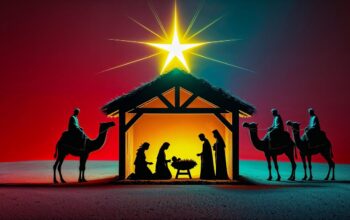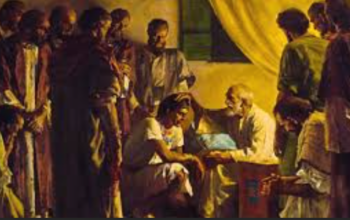One of the most breathtaking stories in the Bible is the discovery of Noah and the Ark, a story of divine intervention and survival in the book of Genesis. Among the many intriguing aspects of this story, the Dove’s role stands out significantly.
In the story, Noah uses the Dove to predict when the floodwaters will recede. In the New Testament, where the Dove represents the Holy Spirit, this is a pivotal event and a primary symbol that is maintained.
This essay explores the Dove’s profound significance in these settings and examines how Noah’s deeds predicted the Holy Spirit’s heavenly mission in Christian theology.
Noah and the Dove: A Symbolic Messenger
In Genesis 8:6–12, we read about Noah sending out birds to check if the floodwaters had abated:
“After forty days, Noah opened the window he had made in the ark and sent out a raven, which kept flying back and forth until the water had dried up from the earth. Then, he sent a dove to see if the water had receded from the ground’s surface.
However, the Dove could find no place to set its feet because there was water all over the earth’s surface, so it returned Noah to the ark. He reached out his hand, took the Dove, and returned it to himself in the ark.
He waited seven more days and sent out the Dove from the ark. When the Dove returned to him in the evening, a freshly plucked olive leaf was in his beak! Then Noah knew that the floods had receded from the earth. He waited seven more days and sent the Dove out again, but it did not return to him this time.”
Noah first sent out a raven, which did not return, indicating that it could find sustenance and a place to rest on the carcasses and floating debris. However, the Dove, a more delicate bird, returned to the ark, unable to find a resting place. This action underscores the Dove’s symbolic purity and unwavering role as a faithful messenger of peace and renewal. The eventual return of the Dove with an olive leaf signified the end of God’s judgment and the restoration of life on earth, giving the Dove the confidence to disembark and begin anew.
The Dove as a Symbol of the Holy Spirit
The Dove symbolizes the Holy Spirit in the New Testament. The most famous example is when the Holy Spirit appears as a dove during Jesus’ baptism, denoting innocence, serenity, and divine blessing. This incident, described in Matthew 3:16–17, the Gospel of Matthew, inaugurates Jesus’ public ministry and provides compelling evidence of the Dove’s function as the messenger of Heaven.
“Jesus emerged from the water right away following his baptism. Heaven opened up at that moment, and he saw the Spirit of God land on him as a dove. And a voice from Heaven said, ‘This is my Son, whom I love; with him I am well pleased.’”
Here, the Holy Spirit descends as a dove, signifying purity, peace, and divine approval. This event, recorded in the Gospel of Matthew 3:16–17, marks the beginning of Jesus’ public ministry and is a powerful testament to the Dove’s role as the Heavenly messenger. The New Testament emphasizes the Dove’s function as a symbol of the Holy Spirit even more, conveying the Spirit’s serene and unadulterated essence.
The Holy Spirit Empowering Believers
Throughout the Bible, the Holy Spirit’s empowerment and guidance of believers are often symbolized or paralleled by the peaceful and pure nature of the Dove. Several scriptures highlight the work of the Holy Spirit among God’s people:
- Acts 2:1–4: The Holy SpDove at Pentecost
- “When the day of Pentecost came, they were all together in one place. Suddenly, a sound like the blowing of a violent wind came from Heaven and filled the entire house where they were sitting. They saw what seemed to be tongues of fire that separated and came to rest on each of them. They were all filled with the Holy Spirit and spoke in tongues as the Spirit gave them ability.”
- John 14:26: The Holy Spirit as a Helper
- “But the Advocate, the Holy Spirit, whom the Father will send in my name, will teach you everything and remind you of everything I have said to you.”
- Romans 8:14: The Holy Spirit as a Guide
- “For those who the Spirit of God leads are the children of God.”
- Galatians 5:22–23: The Fruit of the Spirit
- “But the fruit of the Spirit is love, joy, peace, forbearance, kindness, goodness, faithfulness, gentleness and self-control. Against such things, there is no law.”
- Ephesians 1:13–14: The Holy Spirit as a Seal of Salvation
- “And you also were included in Christ when you heard the message of truth, the gospel of your salvation. You received the promised deposit of the Holy Spirit upon accepting Christ as your Savior. The Holy Spirit’s role was to protect our inheritance until God’s people were redeemed—to God’s glory.”
Connecting the Symbolism: Noah’s Dove and the Holy Spirit
It is possible to see Noah’s Dove’s usage as a metaphor for the role of the Holy Spirit in the New Testament.
As Noah depended on the Dove to return, a sign of life and fresh starts, Christians also look to the Holy Spirit to lead, console, and empower them as they travel through the spiritual world.
The peace and reconciliation that the Holy Spirit brings to humanity through Christ are reminiscent of the olive leaf the Dove brought to Noah.
Moreover, after the floodwaters recede, the Dove returns with an olive leaf, symbolizing God’s steadfast promise and the Dove’s faith. The presence of the Holy Spirit among believers is a reassuring parallel, guaranteeing the fulfillment of God’s promises.
Conclusion
The role of the Dove in Noah and the Ark and its representation as the Holy Spirit in the New Testament underscores a profound continuity in the symbolism of divine messages and renewal.
Noah’s use of the Dove provides a practical solution to determine the state of the floodwaters and establishes a symbolic connection that resonates throughout Christian theology.
The Dove’s purpose and messengers are a stunning metaphor for how the Holy Spirit operates among believers. The Holy Dove provides direction, consolation, and assurance of God’s everlasting covenant, fostering unity and connection among the faithful.




